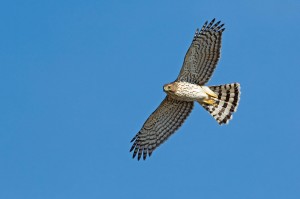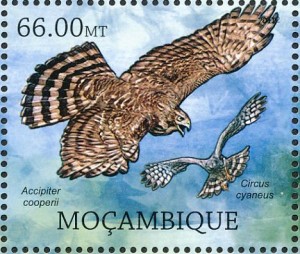Week 12 – 25 September 2016:
That Seems Like a Lot of Foolin’ Around
As I described in an earlier entry, birds are a model of monogamy. There are lots of exceptions, but a bird family usually consists of a mom, a dad and a nest full of happy chicks. This system of mating is attributed to the value of having two parents attending to the needs of their dependent nestlings.
With the advent of genetic technologies, it became possible to determine with certainty whether the social father of nestlings was also their genetic father. It came as a surprise to many researchers to find that, for a wide range of bird species, chicks were frequently the product of a male other than their social father.
The benefit to males of extra-pair copulations is obvious. By sneaking on to the next territory to copulate with a female to which he is not mated gives him the opportunity to pass along more of his genes without the additional cost of caring for the young. The possible risk to the male is that while he is being sneaky with the neighbouring female, another male might be doing the same thing with his mate.
Benefits of extra-pair copulations to females are a little more subtle. By engaging in such behaviour, a female might be protecting herself against the possible infertility of her social mate. She may also be able to copulate with a male that is genetically superior to her mate, resulting in better offspring.
Members of some bird groups seem to do a great deal of foolin’ around. Studies of raptors, on the other hand, have shown that very few chicks are not genetically-related to their social fathers. In part this may be because mated birds of this sort copulate with impressive frequency. Or at least that was the story until now…
In a recent publication, Robert Rosenfield and his colleagues at the University of Wisconsin and the Alaska Science Center showed that Cooper’s Hawks, Accipiter cooperii, are an exception. Studying a breeding population of hawks in Milwaukee, USA, the team collected blood samples from as many adults and chicks as they could. They used a decoy Great Horned Owl to cause adult hawks to fly into a net so that blood samples could be taken; Rosenfield told me that the decoy’s name was LE, pronounced “Lee.” It was a small male, and so looked a bit like a Long-eared Owl.
The team found genetic evidence of a remarkably high incidence of infidelity. Nineteen percent of Cooper’s Hawk chicks in this region were not the product of their social father, and 34% of all broods contained at least one illegitimate chick. Could this be because mated Cooper’s Hawks copulate less frequently than other raptors, allowing greater opportunity for fertilization by other males? Apparently not. In an earlier publication, Rosenfield reported that in the thirty days before egg laying, pairs of Cooper’s Hawks averaged more than twelve copulations a day.
What is the cause of all this foolin’ around in this socially monogamous bird? It seems that male Cooper’s Hawks provide food to their mates, and that food delivery is often followed by copulation. Could it be that females are accepting copulations from additional males, and possibly even soliciting them, in exchange for food before the energetically-demanding period of egg production? The breeding population of Cooper’s Hawks in Milwaukee is particularly dense, and the urban environment is rich in food. Their diet includes sparrows, robins, starlings, doves and chipmunks. Rosenfield et al. suggested that this may make it easy for “females to encounter extra-pair males with prey and trade copulations for food.”
Rosenfield, R. N., S. A. Sonsthagen, W. E. Stout and S. L. Talbot. 2015. High frequency of extra-pair copulations in an urban population of Cooper’s Hawks. Journal of Field Ornithology 86:144-152.
Photo credits: Cooper’s Hawk photograph by Johann Schumacher - www.audubon.org/field-guide/bird/coopers-hawk; Cooper’s Hawk stamp – www.birdtheme.org



